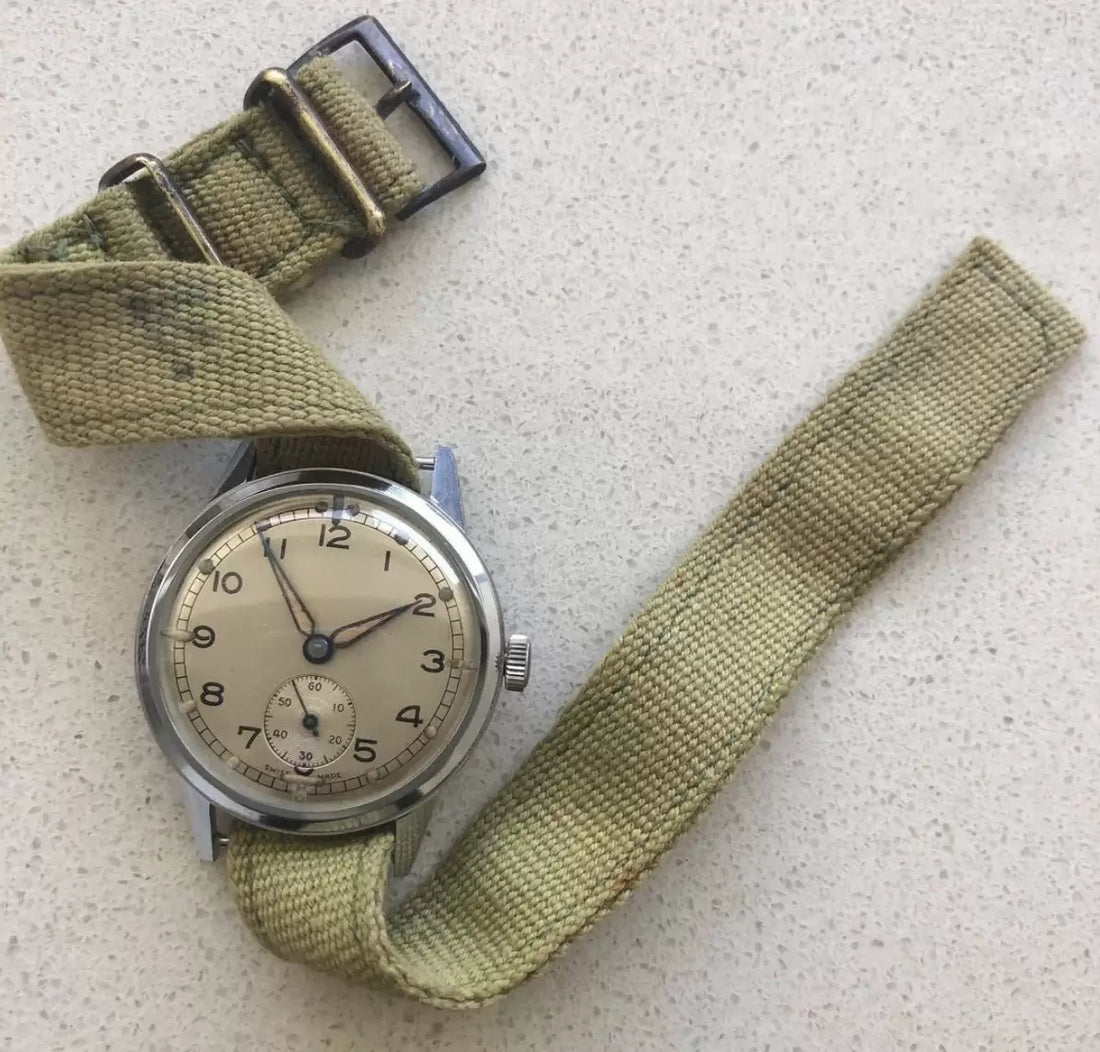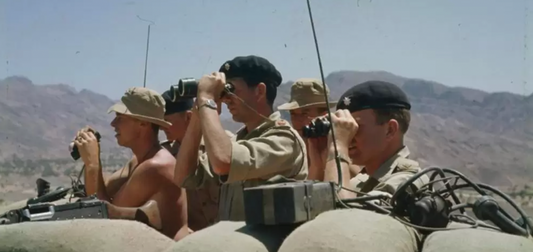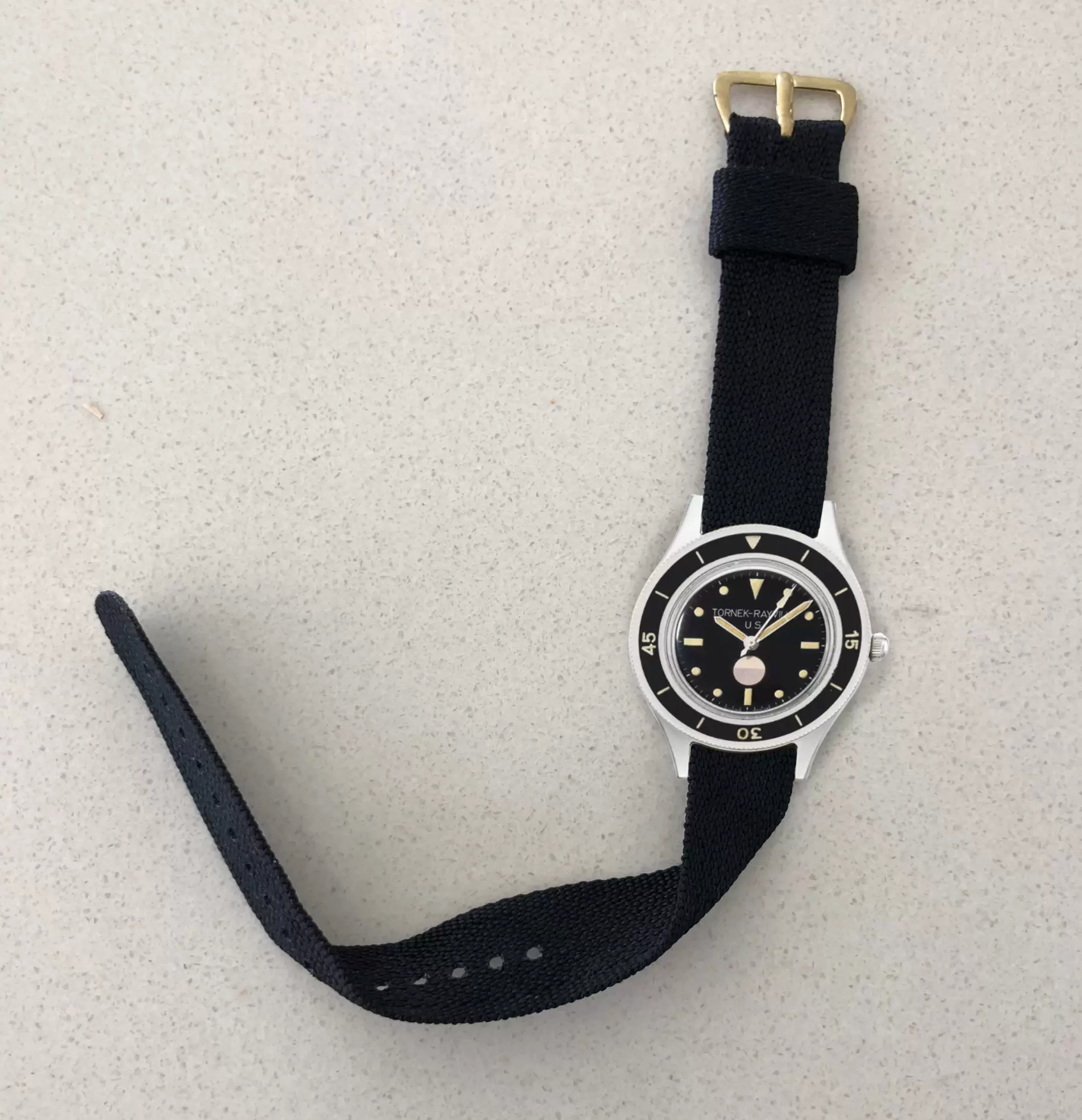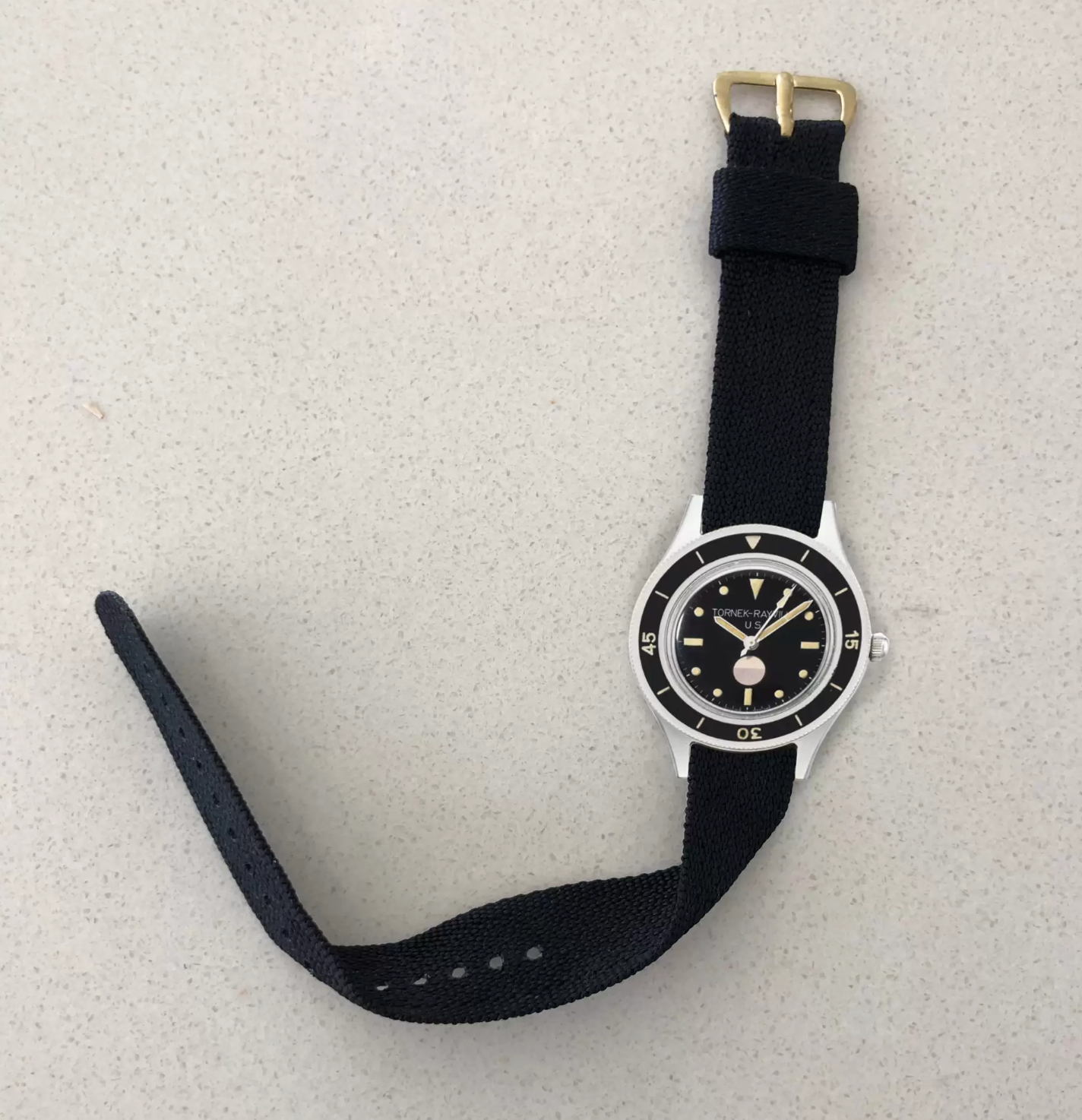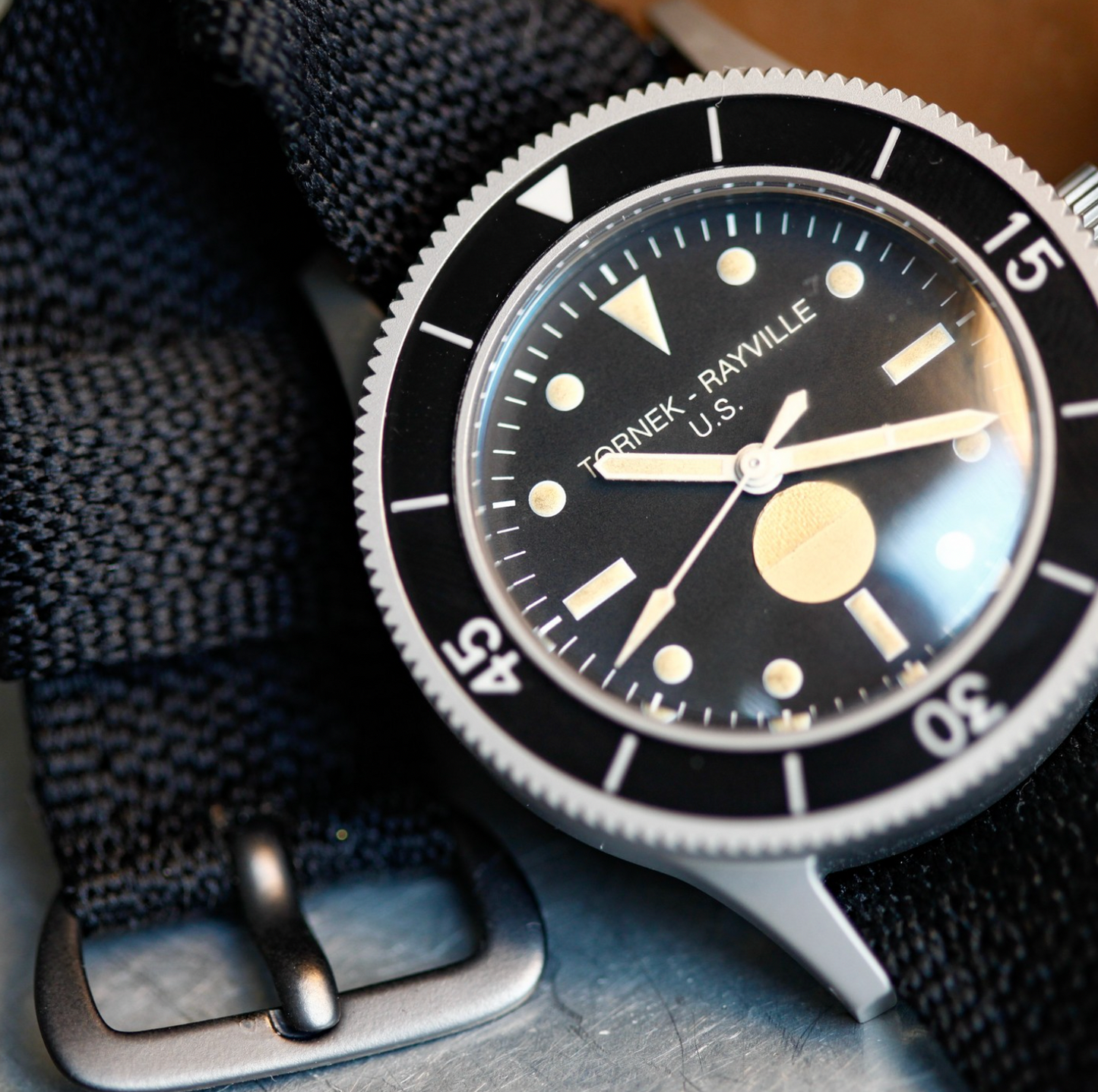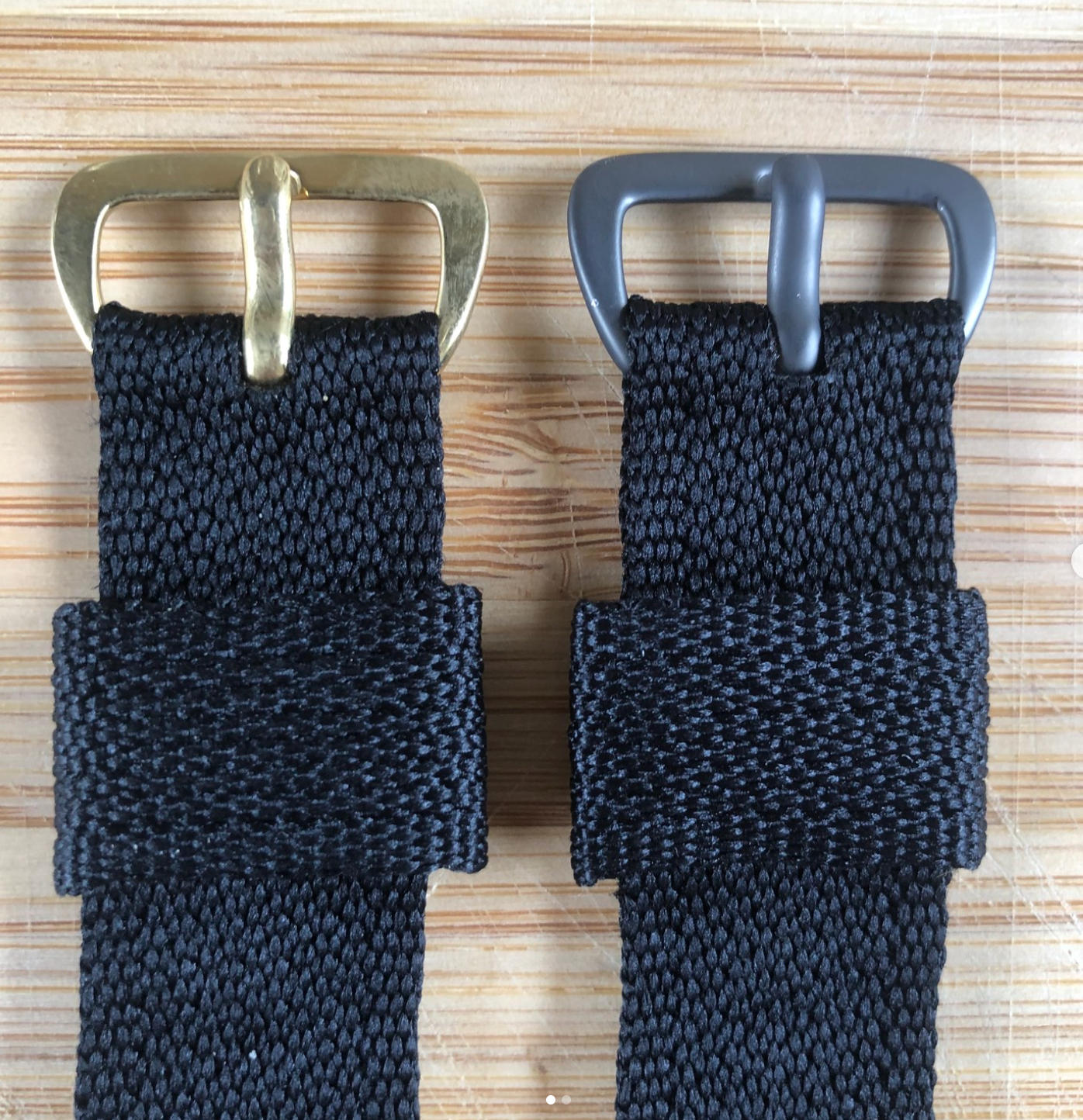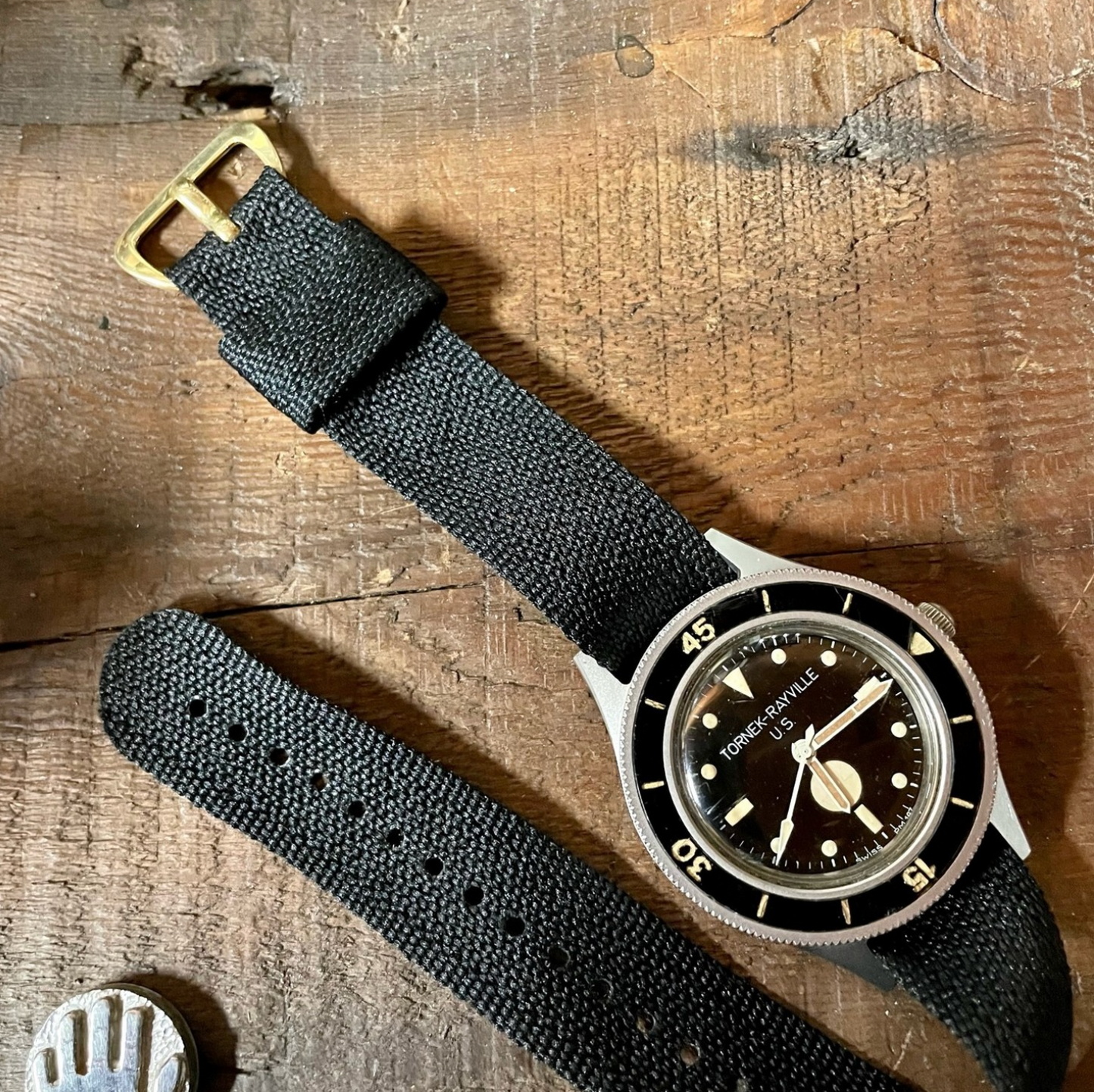INTRODUCTION
An earlier article introduced the WWI era sources of DNA for the NATO watch strap history, as part of the evolution of the military watch. Another such grandfather strap is shown above. Watches were even more of a critical requirement for military manoeuvres and marine and aircraft navigation in WWII than in WWI and were issued much more commonly, according to military purpose.
At the end of WWI, the term wrist watch was in common use, but the wrist watch, particularly in America was not commonly used by men, even by returning service men.
It was only in the late 1920s that wrist watches gained popularity in America. By the time of WWII, watches with lugs and spring bars were common, but pocket watches were not discarded and were still carried by men.
With the Tommy and the Doughboy and his privately supplied wristlet removed from the inhumane conditions of trench warfare, and the advent of specification, provisioning and servicing of watches by the military, there was little need for watch strap innovation in WWII. In the hard times between WWI and WWII the width between lugs on wrist watches widened, spring bars filled the gap, and open-ended two-piece straps became common, so leather straps often prevailed on wrist watches. The US military watch specifications led to the more widespread use of canvas or cotton straps than in Europe.
Nevertheless, just as the Victory strap was developed in WWI, other NATO predecessors appeared in WWII.
WWII WATCHES AND THEIR STRAPS
The wide variety of straps used on wristlets and wrist watches in WWI was in part due to the unforeseen need for military personnel to provide their own watches. In the interval between WWI and WWII, the watch became standard issued military equipment, and defence departments issued specifications to procure watches.
Thus the strap was a consequence of the watch which was specified and issued.
THE GSTP WATCH
(SPEC : GENERAL SERVICE TRADE PATTERN)
The British Army GS pocket watch of WWI was replaced with the GS Mk II in July 1929. Despite the common use of wristlets in WWI to convert pocket watches to wrist watches to free up both hands for the task at hand, the provision of pocket watches to military personnel continued, often when accurate timing was necessary. GS Mk I watches did not exist as a designation, so only GS Mk II watches post-1929 are so engraved, as illustrated below. There is no known specification for GS Mk II watches, but they specifically had a 15 jewelled movement, a black dial, and came on a leather thong.


As the approach of WWII was anticipated the GSTP (General Service Trade Pattern) pocket watch was obtained for the British Army. The GSTP was essentially a commercially available pocket watch with the pheon and GSTP or GS/TP together with an issue number engraved on the back.
GSTP and GS/TP watches are generally branded Damas, Cyma, Enicar, Helvetia, Jaeger le Coultre, Buren, Montilier, Revue and Tissot. They often have white dials due to their civilian provenance.

The drawbacks associated with pocket watches sometimes led to soldering on of wire lugs to GSTP watches and fitting Kitchener type wrist straps as happened in WWI as shown below.

IMAGE COURTESY GOLDSMITHWORKS.COM
The position of the soldered lugs above allowed the crown to be easily accessed.
THE A-7 WATCH
(MIL SPEC : 27748 : AVIGATION TYPE A-7 HACK WATCH)
The US Army Air Corps (1926-1941), predecessor of the US Army Air Forces (1941-1947), and later on renamed US Air Force (1947 – present) adopted Type designations for many of their issued equipment watches such as the “Type A” specification. The type A-11 watch is much more famous and is discussed below.
On October 10, 1934, a US Army Air Corps seven-page dossier described in detail the design and functions of ‘Military Specification No. 27748’ was released. These watches were to be designated ‘Avigation’ watches, a portmanteau of ‘Aerial Navigation’. Type A-7 ‘Avigation’ watches, in compliance to the military specification number 27748, were produced by Longines, Gallet (white dial) and Meylan and for a short period of time were also sold to the civilian market. Chrome-plated metal cases were produced for military use, while for civilian use the cases were made in stainless steel.
The US Army Air Corps Avigation Type A-7 Hack Watch was essentially a pocket watch chronograph adapted for a wristwatch, similar to the GSTP adaption above, making it a large accoutrement – perfect for navigation.
Type A-7 watches are immediately recognizable thanks to their unusual and unique, off-center dials, offset by 40 degrees from the vertical, a co-axial monopusher in the diamond-shaped crown, as well as large Arabic numerals, 30-minute register at 12 o’clock and constant running seconds subdial at 6 o’clock. The single button-pusher incorporated into the crown allowed the pilot to easily start, stop and reset the chronograph to zero. With massive cases measuring 51 mm in diameter, they are true trophies for collectors of military timepieces. The watches were used from 1935 to November 1943 when they were replaced by the smaller A-11 Hack watch.
The watches had fixed bars and were mostly fitted with 2 piece straps which were sewn in place.

BLACK DIAL LONGINES A-7 WATCH

CASE BACK LONGINES A-7 WATCH
THE ATP WATCH
(SPEC : WATCHES, WRISTLET, A.T.P)
Leading into WWII the Army Trade Pattern (ATP) watch was issued to soldiers and was supplied to the Ministry of Defence (MoD) by 17 Swiss suppliers.
Most had the following characteristics:
15 jewelled movement with a round waterproof case in stainless steel or nickel chrome, silvered dial with luminous spots and broad lumed baton hands and a subsidiary seconds register. They all had fixed bars between lugs, as shown on the ATP Enicar below.

The watches were supplied to the MoD without straps. They were then fitted by the MoD with open-ended leather straps with folded metal clips as seen on this Grana ATP below.
The engraving on the case back was the pheon, together with A.T.P. and an issue number.

Below is a NOS Lemania central seconds ATP watch on the original pull through pigskin strap.



Leather straps often perished in tropical conditions and canvas straps were used, particularly in Asia and the Pacific.
An early canvas strap is shown below. This is on a Reconvilier ATP and marked 1941 TOBRUK 7 RTR. The strap appears to be cannibalised webbing with a hand sewn buckle, and has no prepunched eyelet holes.

The AF pattern webbing was issued for tropical conditions. Below is another Reconvilier ATP watch on a WWII period AF0210 canvas strap. ATP watches on AF0210 straps have recently sold on ebay with an approximate strap value of over £400. The date of the introduction of the AF0210 watch strap is unknown, but it is probably about early 1945. The strap had no pre-punched eyelets, and the tongue of the buckle pushed through the canvas allowing it to fit any wrist. The watch strap fitted quickly and easily under the fixed bars of the watch.

The inside of the AF0210 strap was almost always stamped A.F.0210, but some straps were not stamped. Often the pheon was stamped as well.
By 1954 there were records of issue of Watches, Wristlet, A.T.P. under brand names Buren, Cortebert, Cyma, Ebel, Enicar, Eterna, Font, Grana, Lemania, Leonidas, Moeris, Reconvillier, Record, Revue, Rotary, Timor, and Unitas.
While there is some debate about the above manufacturer list, the purpose of the article is to demonstrate that when A.T.P. watches were issued they had fixed bars, and utilised either pigskin or fabric straps.
.
6B/159
(SPEC : RAF PILOTS WATCH)
The RAF also purchased pilots watches from 1940 onward, and engraved its own part number 6B/159 at this time. Open ended leather straps were also fitted prior to issue. This watch was known as the Mk. VIIA. Early watches had a Weems rotating bezel, but later models dispensed with this.
The Weems rotating bezel was patented in 1935, Weems having applied for a method of and apparatus for navigator’s time keeping in July 1929.

Weems worked with Longines originally, but later the patent was used by Omega.

Below is a Weems bezel 6B/159 from 1940 on VB Hygienique NATO type strap.


Some 2500 Weems 6B/159 watches were ordered by the RAF. The original January 5, 1940 order note for 2000 Omega Weems CK 2129 watches, 6B/159 is shown below. Longines, Jager-LeCoultre, Zenith and Movado also provided Weems watches to the RAF.

Later in 1940 non-Weems watches by Ebel (cal 99), Longines (cal 10.68N), and Waltham (cal 870) were issued. The non-Weems style continued with a 1942 issue of Cyma (cal 377), Ebel (cal 101, steel case), Smiths and Movado watches. But by the war’s end, the 1942 issue Cyma, Ebel and Movado watches had often been remarked as a 6B/234, a category requiring less precision.
Then, in the period 1942-45 LeCoultre (redialled later to JLC by MoD), Longines, and Omega CK2292 (cal 30T2 SC) watches were issued. A.M. is Air Ministry.


IMAGE COURTESY MWR FORUM USER : REVO





IMAGE COURTESY MWR FORUM USER: BILL IN SACRAMENTO
In 1956 any 6B/159 watches still in service were re-cased, and had black or white dials fitted. Using RAF part numbers, the 6B/159 was issued on a 6B/169 leather strap, or a fabric strap 6B/321.

Below is a NOS 6B/169 pigskin strap, with the pheon next to the embossing. This was spring loaded and clipped onto the watch.


Image courtesy MWR forum member : Ian.wilkinson
One of the most famous users of an ATP (not a 6B/159) was Sir Douglas Bader. His Timor Watch Company ATP 68012 was sold at Sotheby’s in 1999 together with his dog tag stamped 26151 RAF Bader D.R.S. It had the original open-ended leather straps.

IMAGE COURTESY: WATCHES OF KNIGHTSBRIDGE
Group Captain and Squadron Leader Sir Douglas Bader was an iconic RAF fighter ace and during the WWII was credited with numerous aerial victories despite being a double leg amputee.
The above manual from July 1966 indicates the 1956 Omega white dial 6B/159 was issued on a 6B/169 strap sewn to the watch. An alternative fabric NATO watch strap 6B/321 was also available, but the AF0210 strap was often used in its history.
THE B-1 WATCH
(SPEC : WATCH, WRIST, SEVEN-JEWEL)
The Elgin Pershing wire lug watch of WWI continued as a seven jewel military issue into WWII. It had been covered by specification 55-1A of 7 October 1926, a revision of specification 55-1 of 26 July 1923.
Below is a collection of history WWII Pershings with wire lugs on a variety of NATO watch reproduction strap.

IMAGE COURTESY MWR USER: SCOTT MCCOY
On 13 September 1940, the U.S. Army released specification number 55-1B: Watch, Wrist, Seven-jewel, for a watch designated as the B-1. This specification superseded specification number 55-1A Watch, Wrist, Seven-jewel of 7 October 1926.
The Army specified a manual wound movement of no less than seven jewels, a dial with luminescent hands and markers, a sub-seconds register, a stainless steel case, olive drab strap, and a 90-day warranty.
The watches were to be accurate within +/- 30 seconds per day and to be “reasonably shock resistant and waterproof.”
Bulova, Elgin, Hamilton and Waltham produced the B-1 watch.
The watches are engraved ORD DEPT for Ordinance Department, USA, followed by a code representing the number of jewels, and a serial number. They are generally known as ORD DEPT watches, and many were produced and suffered in the field during use.
The Cal. 987a Hamilton sub-second watch is shown below. It came with a black (Navy or BuShips, to a slightly different specification) or white dial (Army), and is signed Hamilton in black on the dial.
The olive drab straps are NOS.


Below is an Elgin sub seconds watch, on an NOS pull-through strap. This strap could be fitted to one springbar, or used as a pull through.

Military issue straps were olive drab green or tan cloth. Waltham models originally came with two-part straps. Elgin models often had a one-part strap with an Elgin marked buckle, see below.
 Some NOS straps are still available. Original straps are shown below on all watches, both (ORD DEPT) and A-11, although not on the original watch as issued.
Some NOS straps are still available. Original straps are shown below on all watches, both (ORD DEPT) and A-11, although not on the original watch as issued.

IMAGE COURTESY MWR FORUM USER : RIVER RAT THE STRAP WITH CONTRASTING STITCHING CAME FROM A HAMILTON REPAIR KIT.
THE B-UHR WATCH
(SPEC : BEOBACHTUNGSUHR)
The B-Uhr watch was issued progressively from 1940. The specification for these watches was defined by the Reichsluftfahrtministerium (RLM) or Imperial Air Ministry.
The German term Beobachtungsuhr, shortened to B-uhr means an observation or navigation watch.
These B-Uhr watches were made for the German Luftwaffe by 5 manufacturers :
A. Lange & Sohne
Laco (Lacher & Co)
Stowa (Walter Storz)
Wempe (Chronometerwerke Hamburg)
IWC

The B-Uhr specification drawing is shown above, with the long leather looped strap to be worn over flying suits.
All B-Uhr watches had the following features :
A case diameter of 55 mm
Engraved on the back with FL 23883 (FL = flight, 23 = navigation)
Large crowns in order to be used with gloves
Hacking movement (the second hand stops when pulling out the crown to allow precise time setting)
Breguet balance spring
Regulated and tested as chronometers
A long leather looped strap (to be worn on the sleeve of a flight jacket).
Above is a Laco B-Uhr watch. The bars were fixed between lugs, and the straps were riveted into place with 2 rivets per lug.
These straps were not unique to the B-Uhr, and below is a 1930’s Minerva bomb timer on a similar strap.

Due to the popularity of these watches, many homage watches have appeared, and replica long, and shorter more practical straps are available with rivets for replacement.
THE A-11 WATCH AND DERIVATIVES
(SPECS : WATCH, NAVIGATION, TYPE A-11 (HACK) (USA) AND, WATCH WRIST, MK.VIII, NAVIGATOR’S (UK))
The type A-11 was standardised by the United States Army Air Forces in May 1940. It was a navigation ‘hack’ wristwatch with a minimum of fifteen jewels and a sweep second hand. Early 1940-1941 type A-11 watches had white dials, and some had Weems bezels, while the later (1942 onwards) more common type A-11 had black dials. Type A-11 wristwatches were manufactured in accordance with military specification 94-27834, published in 1940.
It developed an enviable record in WWII. This was the watch that kept the US Army Air Forces, as well as the US Navy and Marine Corps, flying, and – to a lesser extent – the RAF (under the 6B/234 designation), the RAAF, the RCAF and even the Soviet Air Force.
For the RAF 6B/234 designation, Ministry of Supply Specification No. G.633 stated :
“Wristlet
A strong leather strap furnished with a substantial buckle shall be securely sewn on to each Mk. VIII watch.”
The A-11 military specification watches were provided by three of the largest watchmaking companies in the United States at the time: Waltham Watch Company, Bulova, and Elgin National Watch Company.
Clause E14 of the specification 94-27834 stated :
“The watch shall be of the wrist strap type. Provisions shall be made where by the wrist straps are easily removed from the watch for replacement. The straps shall be of the sewed type and shall be made of leather or any approved waterproof material.”
Essentially the type A-11 was to be provided with springbars, but a pull through strap would also meet Clause E14. The lug width was 16mm.
The images of the watches below are taken from the Maintenance Manual, TM9-1575.
Top to bottom the watches are Waltham, Bulova, and Elgin.


The watches had either 2 part straps or a one-piece strap with sewn-on pockets for spring-bars as on the Elgin above, part number (F36-) 7198840.

THE ELGIN BUCKLE HAD A SPRINGBAR.

SOME NOS ELGIN LEATHER STRAPS, AND BUCKLES.
The image below is from the Waltham A-11 manual and shows a two-part webbing strap with metal keepers and 9 metal eyelets.

The components of the Bulova strap are shown below.



The keeper for the Bulova strap was a double loop metal stamping.



The case back of the A-11 watches featured quite detailed specification, a growing trend in military coding and identification.

Above is an A-11 Bulova with an open-ended sewn pigskin strap, and fold over metal tabs.


The RAF 6B/234 case markings, as shown above, are much less detailed than the Type A-11 above. Also shown are the metal fold over tabs on the pigskin open-ended strap.
Below is a 6B/234 Waltham without the AM engraving as above, and Waltham 16 jewel 6/0 ’42 movement.


Some 6B/234 cases are overprinting of the A-11 case, demonstrating the heritage. The watch below is on a sewn 2 piece strap.



An unissued A-11 Waltham, still in the delivery box, also on a one-piece cotton strap with sewn-on spring-bar pockets.

IMAGE COURTESY: HOROLOGIUM

A MINT BULOVA A-11 WATCH ON AN ORIGINAL NOS STRAP. THE STRAP IS 230MM LONG.

THE WALTHAM CAL 870 IS SHOWN ON SUCH A STRAP IN THE MANUAL.

Above is another mint Bulova A-11 watch. This on a replacement NOS pull through olive drab strap, with one end held by the spring bar (lug bar).
The instructions say “Slip lug bar through loop”, “Slip end of strap under 2nd bar”, “Strap is now ready to wear”.

Watch bands were a separate item of issue for replacement. Typically a one piece olive drab cotton band, “Strap, Wrist Watch” Stock No. F36-7198840, was used to replace the band issued with the watch.
The US Navy and Marine Corps had a similar specification to the military specification 94-27834B. This was specification Bureau of Aeronautics 88-W-800. Watches were essentially Type A-11 watches, except 88-W-800 required a luminous handset and dial. These watches used the 987s movement and had R88-W-800 on the case back. The watch had cathedral hands. A Hamilton version is shown below.

Below is a USN Bureau of Aeronautics (BuAero) Waltham AERO 88-W-800, Model 10616, size 6/0, ’42, 16 jewel, in a Keystone waterproof case, together with a NOS R88-C-890 wrist compass.

PHOTO COURTESY MWR FORUM USER: HQ_SANDMAN_UTE
The history specification also required that the NATO watch strap be constructed so that the watch could be supported with only one link pin (springbar) in place as shown above. This may have arisen from earlier experience with two-part straps on springbars in active service.
The Navy also had sub-second watches and the US Marine Corps also had watches made and issued to this specification.
Below is a Hamilton 987s, sweep second hand, issued to the US Marine Corps, and a contemporary 1943 advertisement. The NATO watch strap is continuous with sewn on eyelets for the springbars, and this strap allows for one springbar to be lost, and the strap still retaining the watch.


IMAGE COURTESY VINTAGEWATCHFORUMS.COM USER: TSTAPES23
Above is the complete set of watches made in WWII by Hamilton-based on the 987a movement and its derivatives, with a variety of NOS straps. The BUSHIPS or canteen watch is 5th from the left.
The Navy watches are black dialled except for the watch lying horizontally which is a 980 “Bomb Timer” for the Fairchild Gun Camera.

IMAGE COURTESY MWR FORUM USER: BOBBEE
The history wartime advertisement by Hamilton above shows the Hack Watch on a one-piece NATO watch strap, but the other issues Fire Control, Navigation and Service on two-piece straps.
THE W.W.W. WATCH
(SPEC. WATCHES, WRISTLET, WATERPROOF)
From 1945 the British War Office Specification No. R.S./Prov/4373A “Watches, Wristlet, Waterproof” (W.W.W.) for Service wristwatches, replaced the Army Trade Pattern (ATP) specification wristwatch. These remained on issue until about 1985.
This was the first watch specification designed for military use, rather than the military using watches being adapted from an available civilian design. The W.W.W. watch had a black dial, subsidiary seconds and luminous paint for the numerals and hands. It also had fixed bars. It was not shockproof.
The NATO watch strap is a consequence of this fixed bar military standard, a product of the history evolution of the pass through strap. These watches were originally issued with either pigskin or AF0210 canvas straps.

IWC WAS ONE OF 12 SUPPLIERS OF W.W.W WATCHES TO THE MOD IN UK.
About 150,000 W.W.W watches were delivered to the British military by all 12 manufacturers delivered from May 1945 until December 1945, including some 6,000 IWC watches.
Unlike the more collectable post war Mk. XI’s, these watches were produced for the Army and not for the RAF, and many refer to them as Mk. X’s. They were 35mm without the crown and had 18mm lugs. They were equipped with the 83 calibre IWC movement.
Interestingly, watches to this standard arrived towards the end of the war, and were mostly “decommissioned” and sold to the public.
The W.W.W watches were issued with an open end pig skin NATO watch strap with flexible metal strips to attach the strap to the fixed lug bars or leather pull through straps. Alternatively, and more rarely, towards the end of the war they were equipped (or retrofitted) with the 44 pattern webbing A6/AF2010 pull through canvas strap as shown below on a IWC (Ref 1).

RECORD W.W.W. ON A TWO PART PIGSKIN STRAP, ABOVE.


PULL THROUGH LEATHER STRAPS SHOWN ABOVE. IMAGES COURTESY MWR FORUM USER: ISOLOGUE

IWC W.W.W. ON AN AF0210 STRAP.

THIS A6/AF0210 STRAP IS JUST MARKED AF0210 AND APPEARS TO BE DATED 1945. THIS TIES IN WITH THE INITIAL USE OF THE 1944 PATTERN WEBBING. IMAGES COURTESY MWR FORUM USER: BALDHEAD
The AF0210 strap was part of the 1944 pattern, or 44 pattern webbing, and was promulgated in the VAOS of 1945, Section A6 : Jungle Warfare Equipment.

Above is the 1948 edition of the VAOS, Section A6: Jungle Warfare Equipment which superseded the VAOS of 1945.
Designed for jungle and tropical climates 44 pattern webbing was introduced in 1945 for the Pacific theatre just as WWII ended, and was still in use in one form or another until it was replaced by Personal Load Carrying Equipment (PLCE) 90 pattern webbing. It was mainly tropical theatre issue only. It was used in campaigns in Palestine in 1946, the Korean war, Malaysia and Borneo 1963-1966 (following the Malayan emergency), in Kenya against the Mau-Mau, far East campaigns and in the Suez Campaign. Australian troops serving with British forces in Malaya during the 1950s were issued with it.

Above is a soldier history shot in Malaysia, with a watch on AF0210 webbing NATO watch strap, cooking in an AF0225 mess tin, (store reference A6/AF0225 Tins, mess, rectangular, aluminium), with the indispensable A6/AF0100 machete or parang in the foreground (machete marked M.S. Ltd 1945 AF0100 with pheon). The machete scabbard was store reference A6/AF0101. Other issued machetes were of the Malaysian Golok style manufactured by Martindale, marked KE8277 (for the Kenya campaign?).
The AF0210 strap was not part of the individual 44 webbing set issued to personnel. It is a fine weave soft two-ply strap, about 250mm long, folded over at the tail end, and sewn all around. Hence the tail end is square. There are no prepositioned eyelet holes, and the tongue of the buckle can be positioned anywhere. The strap is self-sealing, and the positioning holes rarely can be seen after use, as can be seen above.
The full list of W.W.W. suppliers is provided below.

IMAGE COURTESY : KONRAD KRINIM
The suppliers were Swiss as UK manufacturers did not have the capacity to produce the watches, and the watches were allocated a UK Stores number and for some a (retrospective) NATO Stock Number (NSN) as listed above. These watches are known as the “Dirty Dozen” by military enthusiasts (Enicar did not produce any) and are covered extensively elsewhere.
The grail of W.W.W. watch collectors is to have a good to an excellent example of each of the “Dirty Dozen”.

THE “DIRTY DOZEN” ON PIGSKIN LEATHER STRAPS.


OMEGA 1953 WATCH LEFT, ON A CANVAS NATO STRAP. RIGHT, AN IWC WWW WATCH, WITH NATO DIAL, IN A CANVAS AF0210 STRAP. IMAGE MWR FORUM USER: T.O.W.S. UK.
BUSHIPS CANTEEN WATCH
(SPEC : WATCHES , WRIST, WATERTIGHT)
During WWII the British Navy commissioned about 50 special watches for their divers to wear. These were specially cased made by Albert Thomas Oliver with Longines Cal 268N movements, and an Omega 30T2SC. They had a screw-on cap that prevented the winding crown area from water penetration and had wire lugs. This meant that they used hand stitched pigskin straps. They were issued with Hydrographic Survey markings, HS with the pheon, as shown below.


IMAGES COURTESY MWR FORUM USER: JAMES DOWLING
When the US Navy needed divers watches approaching D-day, specification 18W8(INT) of 1 December 1944 covered the production of a Hamilton diver’s watch which had a similar design concept, and also had a screw-on cap that prevented the winding crown area from water penetration. These BuShips watches were thus nicknamed “Canteen” watches.
The US Navy Bureau of Ships (BuShips) was established 20 June 1940, and was responsible for shipping, shipyards, maintenance and salvage. Hamilton USN BuShips canteen watches had a 987s movement were issued to members of the Naval Combat Demolition Unit (NCDU) underwater demolition teams (UDT), who were responsible for clearing harbours and obstructions during the war.
The above specification was replaced by Specification 18W8(SHIPS) on 15 January 1947.

The straps were either two pieces, or one piece, moulded nylon. The strap above reads “USN” and “Ranger-Tennere “.

The one-piece NATO watch strap is Part Number 7646909, and has a chevron marked tail. The outside of the one-piece strap strap reads Ordnance Dept USA, Part No 7646909.

This NATO watch strap is history similar to the one-piece cotton strap with sewn-on spring bar holders used for the A-11, and was later incorporated into MIL-S-3035 of 8 September 1949.
By the end of WWII pigskin or cotton and canvas straps were in widespread use, the latter perhaps more in the tropical conditions of the Pacific theatre, apart from the moulded nylon strap above, and some metal straps discussed below.
WWII CANVAS OR COTTON STRAPS
A variety of original straps are shown below, with the 2 straps with metal eyelets 4th and 7th from the top being reproduction straps, rather than those having sewn eyelets.

IMAGE COURTESY MWR USER: RIVER RAT
The history B-1 watch specification for an olive drab strap led to the replacement NATO watch strap which was listed above for the A-11.
Typically a one-piece olive drab cotton band, “Strap, Wrist Watch” Stock No. F36-7198840, was used to replace the band issued with the watch.
The Bulova 2nd from the bottom in the above picture is history thought to be on an original one piece NATO watch strap with sewn on spring-bar pockets. This is very similar to the Elgin strap shown in Figure 142 of the Maintenance Manual, TM9-1575.
The pull through Brite strap below could also be used. It had a pocket into which a spring bar could be fitted to help retain the watch.

Manufacturers such as Brite, Guss and the American Strap company provided a range of canvas or water repellant two piece poplin straps.

The American Strap Company of New York NOS strap is shown below.

A NATO type strap numbered 6032 was also sold as a replacement cotton strap.

IMAGE COURTESY MWR USER: JOE A.
VB Hygienique also supplied bands and by the end of WWII the VB Hygienique canvas band had evolved from a straight canvas history strap to a NATO watch prototype.





Credit for top and right images MWR user : Revo
The WWII US Army VB Hygienique band is shown above. The buckle according to history has a central bar and can be moved along the NATO watch strap to change the position of the keeper for the watch.
The VB Hygienique band above drew heavily on the Victor strap, and foreshadowed the NATO strap.
WWII STAINLESS STEEL STRAPS
Stainless steel clip straps were developed during WWII. A Berkely lifetime bracelet (left), and a Don Juan clip are shown below.



These did not prove popular, but they were easy to improvise and individualise as on this A-11.

Stainless clasp watches also existed. This reads: The Captain, GEMEX CO, Chrome Steel, USA Pat. Pending near the buckle.

THE BARON WAS ANOTHER STAINLESS STEEL MODEL.

THE SURE-STAY WAS ANOTHER MODEL WHICH DID NOT REMAIN POPULAR.

FLEXIBLE STAINLESS STEEL STRAPS.
A variety of stainless steel or “Staybrite” straps were available at the commencement of WWII.
W. M. Krementz in 1929 filed to patent a ladder-type bracelet which was infinitely adjustable. A two-tone example is shown in the middle and a stainless (Kremaloy) example on the right with an Ernest Borel Incastar watch.
The patent number 1779068 was granted on 21st October 1930.
.


Soon after Krementz’s application in USA, the nearly identical Bonklip strap was patented in K.
D. R. Howlitt filed a British Patent application on April 6, 1930, for an almost identical invention which was UK patent number 349657. The early Bonklip models were patterned.

This NATO watch strap was in stainless steel, and was used during WWll history on a variety of watches. There are few, if any, examples of US military watches on Krementz straps. However, there are many examples of UK military watches dating from the 1940’s on Bonklip straps.
Below is an Enicar ATP on a Bonklip strap. The clasp reads ‘Made in England’ ‘B.H.B & S’ ‘Pat

AN OMEGA WEEMS 6B/159 IS SHOWN BELOW ON A BONKLIP.

LEATHER STRAPS
Topps produced one-piece leather replacement straps which allowed the watch to stay on the wrist if one spring-bar was lost. But, the cotton straps remained the most popular item.

A 1945 US patent by Alexander Greenberg was for a leather NATO style strap, not dissimilar to the Topps strap above.

The strap was embossed with the patent number.

Image Courtesy MWR Forum member : Moclovflop
CONCLUSION
The British military continued with fixed bar watches in WWII and this led to many open-ended pigskin straps. However, the end of WWII saw two versions of the NATO strap, in cloth, and on canvas. Pull through cotton, and leather were the other straps of choice for fixed bar watches.
RECOMMENDATIONS
THE STARTER
The VB Hygienique strap is sometimes available as NOS and currently fetches about $50. This cloth forerunner to the NATO watch strap is notable in history for its adjustable central bar buckle and cloth keepers. These are getting to be rare.

IMAGE COURTESY MWR FORUM USER: REVO
THE KEEPER
The keeper is the AF0210 canvas pull through, which dates from about 1944/5.
It is seen on both ATP and W.W.W. watches of this era, and is shown below on a Vertex W.W.W. While easily and cheaply replaced in WWII conditions, the canvas strap did not last forever, and few are seen these days. NOS straps are rarely available. A recent sale of a watch with an AF0210 strap indicated a strap value of about $200.

THE GRAIL
The grail would be a canvas NATO strap of the era. The exact date of issue is not known. It is shown in the W.W.W. section above on an Omega, next to an AF0210. Below is another image. The strap is essentially an AF0210 strap (but with a different chamfered corner buckle) with an extra canvas keeper loop attached. Expect to pay several hundred dollars for a good example of this NATO grandfather.

IMAGE MWR FORUM USER: T.O.W.S. UK
REFERENCES
Ref 1 ‘On His Majesty’s Service 3’ – Third part of series on Watch, Wrist, Waterproof (W.W.W.) , Thomas Koenig and Adrian van der Meijden, Horological Journal October 2008. pp 441-443.
